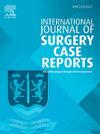Loss of a limb: A consequence of traditional bone setting
IF 0.6
Q4 SURGERY
引用次数: 0
Abstract
Introduction and importance
Traditional bone setting (TBS) is commonly practiced in many communities worldwide, especially in developing countries in Asia, South America, and Africa, where healthcare resources are less developed. It plays an important role in healthcare delivery systems and remains a widely used alternative to modern medical care for limb fractures. This practice involves using wooden straps and casts to immobilize and stretch the injured limb, often leading to complications such as non-union, malunion, infections, compartment syndrome, and even limb amputations.
Case presentation
We discuss a case of a 30-year-old male patient who arrived at our facility with infected and gangrenous forearm with compartment syndrome following a week after traditional bone-setting intervention. The patient required an urgent fasciotomy and extensive surgical debridement of necrotized tissues. Due to extensive tissue loss, ischemia, gangrene, and persistent limb hypoesthesia and paresis, a forearm amputation was ultimately performed.
Clinical discussion
The traditional bone setter is a lay practitioner of joint manipulation, often lacking formal medical training. Despite the availability of modern healthcare systems, traditional bone setting continues to be widely used in many communities, leading to severe complications when improperly performed. In rural areas, traditional healers may not have the necessary knowledge to manage limb fractures appropriately, resulting in inflammation, infections, and delayed treatment. Strengthening healthcare delivery requires additional training for traditional healers and increasing public awareness about trauma care and early hospital referrals.
Conclusion
While traditional bone setting holds cultural significance, it poses serious risks, including infection, gangrene, and limb amputation, as demonstrated in this case. This report highlights the urgent need for community education, improved trauma awareness, and enhanced integration of safe, evidence-based fracture management in rural settings to prevent such complications and improve patient outcomes.
求助全文
约1分钟内获得全文
求助全文
来源期刊
CiteScore
1.10
自引率
0.00%
发文量
1116
审稿时长
46 days

 求助内容:
求助内容: 应助结果提醒方式:
应助结果提醒方式:


